Chapter 16 Distraction and learning

Sometimes, we may feel a bit like the leftmost monkey above, trying to ignore the sounds around us so that we can pay full attention to something we are looking at. Other times, we may want to concentrate on something we are listening to, in which case shutting our eyes like the monkey on the right might be a good idea.
It would be nice if we could simply turn off our hearing or vision at times and thereby avoid distractions. As we discussed in 5, however, as creatures that evolved in a dangerous world, our brains are evolved to be continually vigilant.
This is most obvious in prey animals. Horses are an example. To avoid being eaten by wolves and other predators, horses evolved large, side-mounted eyes that give them almost 350° of vision, with only a small blind area. This helped them detect predators that might otherwise sneak up on them.
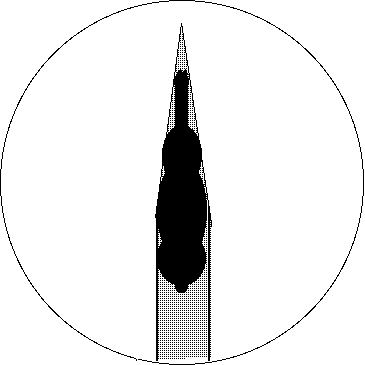
Figure 16.1: Schematic of a horse from above. The black area is the horse, the white areas depict the visual field, and the very small blind region is in grey.
“Getting spooked” refers to when a horse becomes startled or afraid, which can be triggered by something they see or hear, and can cause them to flee (bolt). As prey animals, they are always vigilant for possible threats.
To avoid triggering their flight response, some owners of horses fit them with blinders to restrict their field of vision. Whether a horse’s owner is trying to get it to pull a carriage or to win a race, the blinders, also known as “blinkers”, help keep it on task by preventing anything to the side or behind from spooking the horse.
Humans may have not had as much to fear from other animals as horses did, but we still faced dangers in our ancestral environment, from other people as well as from predators like lions. Like that of horses, our brains are constantly monitoring incoming signals from all our senses for things that might be a danger. And as social animals, we are also innately attuned to the presence of other people.
When I’m working at a café, the faces of other customers often distract me from my work. I sometimes literally blinker myself to avoid this. I’ll bring a baseball cap, and pull the brim down so that I don’t see as many of the faces that are coming and going.
Sleep is different in that vigilance is reduced, but even during sleep a loud sound, a bright light, or a strong touch can reliably wake people up. Not babies, though - they can be much harder to wake. They evolved to rely on adults for their defense, so they can afford to concentrate on brain development rather than monitoring the environment.
The top-down attention chapter (5) introduced the idea of attentional capture. The experiment discussed there, by Theeuwes et al., used these sorts of displays:
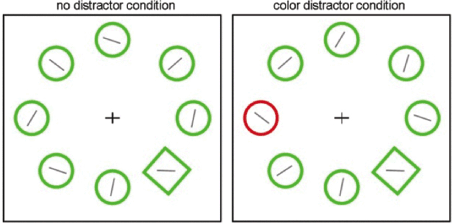
The task for participants in the experiment was to find the diamond and determine the orientation of the line within it. People took longer to do that in the presence of an odd-colored distractor like the red circle at right. On some trials, participants couldn’t help but shift their attention to the red object, and only after that did they attend to the diamond. All sorts of sensory signals can be distracting, of course, not just odd-colored items.
Odd sounds, for example, are often distracting - hearing is especially important for “interrupt signals” (5) because hearing constitutes an early warning system. With vision, you need to look around, moving your eyes about, to detect any threats around you. With hearing, in contrast, you can detect things anywhere around you without even moving your ears and your head. Indeed, most of us aren’t even able to move our ears, which is fine because we don’t need to move our ears or head to listen in all directions.
Some people can move their ears, but there’s not much reason to do so.
Because of our vigilance system, sudden sounds in an otherwise quiet scene can distract our attention, taking us off task. When that happens, the sound is a lot like an odd color in a scene. Similarly, if you feel a sudden touch on your body, this will also attract your attention. Indeed, preventing a touch from alerting people is the primary challenge faced by pickpocketers. The magician and pickpocketer Apollo Robbins discussed in 14 addressed this by touching his victims continuously, so that the touches corresponding to removing the victim’s watch wouldn’t be registered as anything special.
16.1 Bottleneck review
Previous chapters emphasized that many changes in a scene can go completely unnoticed. That’s true even if the changes are highly unusual, as long as they don’t stand out by being the only location associated with a flicker or motion signal. Due to the brain’s bottlenecks, some objects in a scene are usually never fully identified. So, most of the unusual aspects of a scene will never have a chance to attract attention because they aren’t processed enough by the brain for the brain to determine whether they are unusual. If you show someone a cluttered scene and then tell them to find any unusual objects in it, it will take them a long time to do so, just as it takes a long time to find Wally in the scenes of the Where’s Wally books. One has to move attention around the scene to recognise the objects, possibly one-by-one. The only scene-wide processing for unusual things is limited to a few features, like color and orientation.
These issues are illustrated by the wimmelbilderbuch (literally “teeming picture book”) tradition of illustrations popular in the 16th century. Also known as a hidden picture book, the pages contained many disparate figures and objects.

Only by attending to each part of the image in turn could one recognise the objects that were there. In the painting shown here, the artist Pieter Brueghel depicted people enacting Dutch idioms that children were meant to learn, such as “swimming against the tide”, “banging one’s head against a brick wall”, and “armed to the teeth” (“Netherlandish Proverbs” 2021).
In summary, apart from the unusual objects associated with an unusual color, shape, or flicker/motion, the surprising things in a scene typically won’t attract attention and so they typically won’t be processed extensively. A secondary question, which we will turn to now, is which sorts of things will hold attention if they actually are fully processed.
16.2 Avoiding a bottleneck to test potential distractors
A way that researchers can ensure that objects are processed extensively is by presenting them one-by-one, right where the study participant is looking. This is called the rapid serial visual presentation method and we already saw it used to reveal a memory bottleneck in the previous chapter (15).
Asplund et al. (2010) used this technique to investigate what attracted attention in conditions where many different objects were briefly presented, but the participant’s task was to attend to just one. They used a rapid stream of letters, like those of the movies in 15. In one of the Asplund et al. (2010) experiments, participants had to identify one of the letters in the stream. On some trials, however, they replaced one of the letters with a photograph of a face.
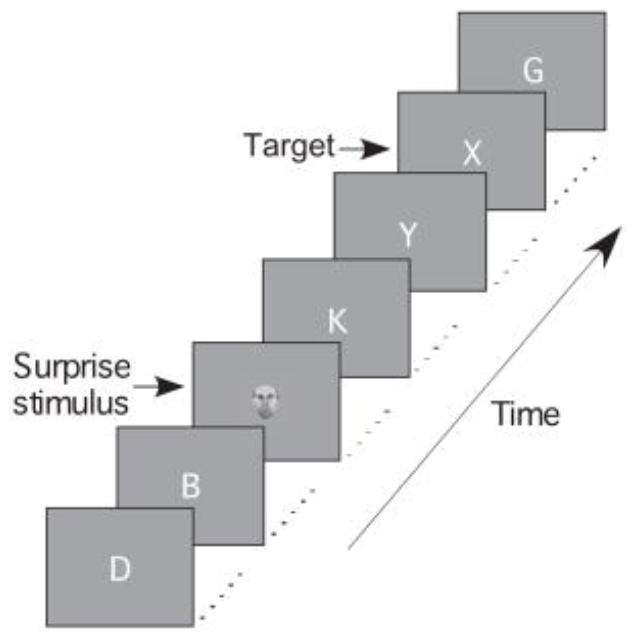
The sudden appearance of the face was a surprise to the participants. On those trials where it was included, performance identifying the letter often was worse. Specifically, if the letter was shown within about half a second after the face, accuracy reporting the letter was worse. The faces were proven to be effective distractors that held attention.
You might have guessed that faces would be potent distractors. After all, we are social beings, and as discussed in Section 10.1, given the chance, many people spend a lot of time looking at the people in a scene. However, Asplund et al. (2010) found that the disruption of performance by an unexpected image was not specific to faces.
In the experiment, half of participants were actually shown a stream of faces rather than a stream of letters.
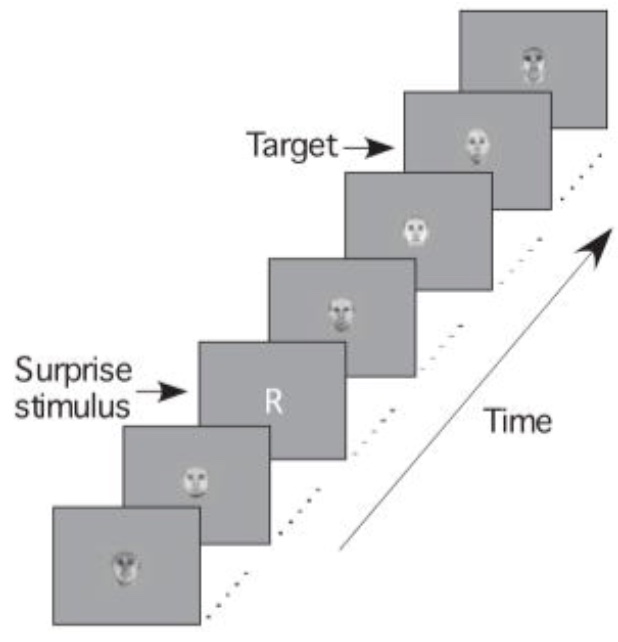
The participants’ task was to identify a target face, not a target letter, but in some trials, a letter was included in the stream. The results were quite similar to those for the participants who viewed a stream of letters rather than a stream of faces. That is, when the surprise letter was presented less than half a second before the target face, participants were less likely to report that they had seen the target face.
 The black squares show the data for the participants who were shown a surprise letter. Participants did poorly if that letter was presented 130 or 390 ms before the letter, but they did fine if it was presented 780 ms later. In summary, the odd stimulus disrupted performance for something like half a second. During that interval, participants missed the target face about half the time.
The black squares show the data for the participants who were shown a surprise letter. Participants did poorly if that letter was presented 130 or 390 ms before the letter, but they did fine if it was presented 780 ms later. In summary, the odd stimulus disrupted performance for something like half a second. During that interval, participants missed the target face about half the time.
The same pattern was seen for those participants who saw the stream of letters punctuated by the surprise presentation of a face, as shown by the white circles in the plot. Performance was slightly poorer for this condition, which could be caused by faces being inherently more distracting than letters. To investigate this possibility, Asplund et al. (2010) tried using other images besides faces in the letter stream and compared their effects to those of the faces.

The results yielded no significant difference between using any one of these images as a the surprise rather than the face, so although faces may have more distracting power (Langton et al. 2008), that didn’t make much difference in these experiments. More important was simply that the stimulus presented was different than the rest, an oddball, rather than it being a particular kind of oddball.
When something distracts you, if it’s something that interests you, you may simply choose to stop doing whatever you were in the process of doing. In that case, it’s obvious that this would impair performance of the task you chose to stop doing. What’s more interesting is when a distracter reduces your performance even though you are trying to completely ignore it. This is what was happening when the odd-colored items in the visual search experiment elevated response time (10.1) and in these Asplund et al. (2010) experiments with the images.
16.3 Surprise!

A major reason that attention was attracted to and held by the rare face presented among letters (Asplund et al. 2010), was because the face was simply different from the other stimuli presented in the trial. But another factor is the actual unexpectedness or surprise of seeing the face there’s also another phenomenon contributing to the results. Remember that each participant saw the unusual stimulus in four of the thirty trials they participated in. In the first trial that the unusual stimulus appeared, it must have been very surprising, but not so surprising the third or fourth time. When Asplund et al. (2010) broke down the results in this way, they saw the results were different the third or fourth time.
Most of the deficit caused by the unusual stimulus was confined to the first one or two trials. After that, participants did much better. So a lot of the problem was the surprise itself. After participants began to expect the stimulus, the unusual stimulus had much less effect; participants were much less distracted by it.
A good deal of the effect of distractions, then, comes from them being unexpected. After a particular event has repeated many times, it has less effect on reactions of many kinds, not just the kind of distraction assessed in these experiments. This is called habituation. Habituation, the decrease in response to a stimulus after repeated presentations, is a kind of learning. Neurons across much of the brain respond less to repetitions of an input than to the first exposure of an input. Habituation serves a variety of purposes for the brain, but here our point is just that it can reduce the orienting of attention to a stimulus.
Unfortunately, habituation is rarely complete. In the Asplund et al. (2010) work as well as the Theeuwes et al. experiment (5), even after many repetitions the average participant wasn’t able to entirely prevent those salient stimuli from interfering with their performance.
In summary, there are two things going on in such cases:
- An unusual stimulus can attract attention, disrupting task performance for about half a second in these circumstances.
- If the stimulus is a surprise, the disruption is greater.
And don’t forget, the stimulus has to be processed enough for it to be registered as unusual (which the researchers ensured by presenting them one-by-one).
Would it be possible to make a list of all the stimuli that, if processed, would attract attention? Perhaps not, because it may depend on the person. Have you ever been talking to a few people but then overheard someone else say your name in a separate conversation? When that’s happened to me at a party, I’ve found it very difficult to keep concentrating on the conversation I was in, even if it was an important conversation with my boss. I might manage to keep my eyes on my boss, when he finished his sentence I’d realise that I didn’t know what he had said.
Emotionally arousing stimuli are one stimulus class that may attract attention in most people. In the laboratory, one way that’s been studied is by presenting a rapid series of images and testing people on which ones they remembered. By inserting different sorts of images in the stream, researchers can determine which ones are the most distracting. One study done by an honours student, Katherine Saunders, in my laboratory used that procedure. Watch this movie to see an example image sequence from Katherine’s experiment.
After people were shown the movie, they were asked which of the below image(s) had been presented.
 We found that participants were less likely to remember the couch than the other images. The reason for this is that it was placed soon after a very arousing image of a dead body.
We found that participants were less likely to remember the couch than the other images. The reason for this is that it was placed soon after a very arousing image of a dead body.
Distractions like emotionally-charged images can cause people to completely miss pictures that are presented soon after them. Based on hundreds of experiments investigating this and related effects, researchers believe part of the reason is that consolidating sensory signals into memory takes time, as we described in the previous chapter (15). Once your attention is attracted by something, your mind will often process it for storage in memory, hampering your mind’s ability to process other items into memory that occur around the same time. Unlike for the faces and letters used by Asplund et al. (2010), repeated presentation of such stimuli may not reduce their effect much (Onie, Donkin, and Most 2021); in other words, there may be very little habituation.
16.4 Learned and not learned
In the beginning of this chapter, and elsewhere (5), we referred to the importance of an alerting system in evolutionary history. Some of these alerts are probably hard-wired into our brains by evolutionary history, rather than learnt. Charles Darwin himself (Darwin 2009) in 1872 suggested this possibility, when writing about a trip he took to the zoo.
I put my face close to the thick glass-plate in front of a puff-adder in the Zoological Gardens, with the firm determination of not starting back if the snake struck at me; but, as soon as the blow was struck, my resolution went for nothing, and I jumped a yard or two backwards with astonishing rapidity. My will and reason were powerless against the imagination of a danger which had never been experienced.

Darwin believed that his fearful reaction to snakes was innate rather than learned. Subsequent evidence has provided some support for that idea, at least in other primates (Shibasaki and Kawai 2009); it is difficult to confirm this in humans. Many of the things that attract our attention, however, must be learned. Evolution could not keep up with the changing array of important things in our ancestral environments, and our environment and associated lifestyles are changing even more rapidly today.
The habituation learning evident in the Asplund et al. (2010) work helps reduce the tendency for us to be continually distracted by things. However, the world today presents a constantly-changing set of distractions, so you will not habituate to everything, even if that were desirable.
16.5 Rewards make distractors more distracting
We have a dog in my household, and his name is Hugo. Most of the time, Hugo doesn’t pay a lot of attention to me or to the other people in the house.

But when one of us starts shoveling dog food into Hugo’s bowl, the impact of the food against the ceramic bowl makes a characteristic ringing sound, and Hugo will leap to attention. Hugo has learned to associate the ringing sound with the reward of food.

I think that even if Hugo were trying to concentrate on another task, the ringing sound would distract him. Something like that certainly does happen in humans! For example, in a visual search experiment based on the study we discussed by Theeuwes (5), Le Pelley et al. (2015) asked participants to judge whether a little line they presented inside a diamond on each trial was horizontal or vertical. Le Pelley et al. (2015) also included an odd-colored object in each display, to distract the participants. There were two major changes compared to the Theeuwes study. First, the participants received money for each correct response. Second, they earned a greater amount (10¢) if the distractor were one particular color, while they made less money (1¢) if it were another.

The best strategy for participants to maximise their earnings was to completely ignore the distractor and its color. You already know from chapter 5 that people can’t do that: the odd-colored distractor will slow them down. The new factor here was whether the distractor that indicated the reward would be 10¢ would affect people any differently than the distractor that indicated the reward for that trial would be just 1¢.
To end up with as much money as possible, if they can the participants ought to concentrate more on the target when the distractor indicates a large reward than when it indicates a small reward. However, this is not what happened! Instead, responses were slower when the distractor indicated the trial was high value than when it indicated the trial was low value.
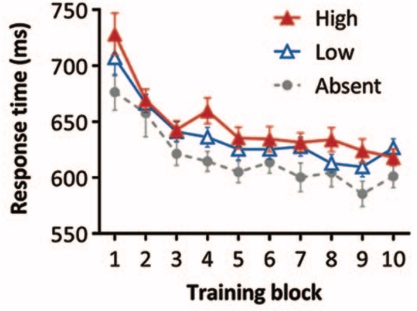
Evidently, the participants attended more to the distractor that was associated with a stronger reward, even though this reduced how much money they received at the end of the experiment. Stimuli that are associated with greater rewards seem to attract more attention, even when that is completely counterproductive.
This brings us to the situation we all face with modern technology and devices.
16.6 Exercises
- What does the bottleneck on object identification have to do with what can distract you?
- What lesson did Darwin draw from his experience with a snake at the zoo?
- What do you find most distracting when you are trying to watch a lecture? What is most distracting when you are trying to study?
.jpeg)